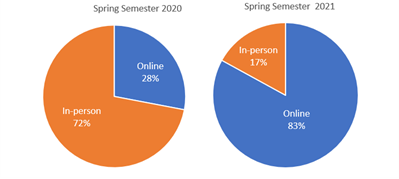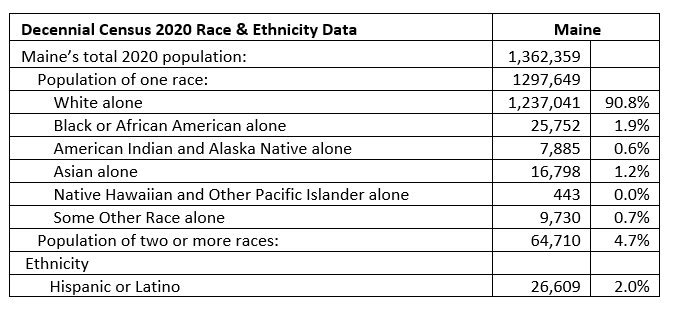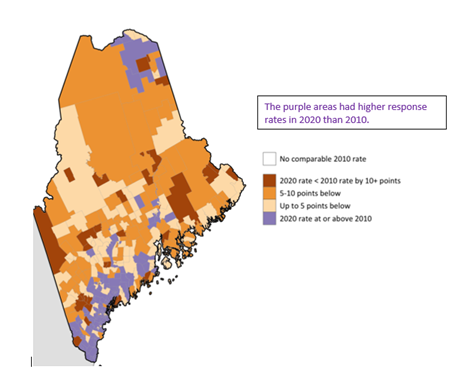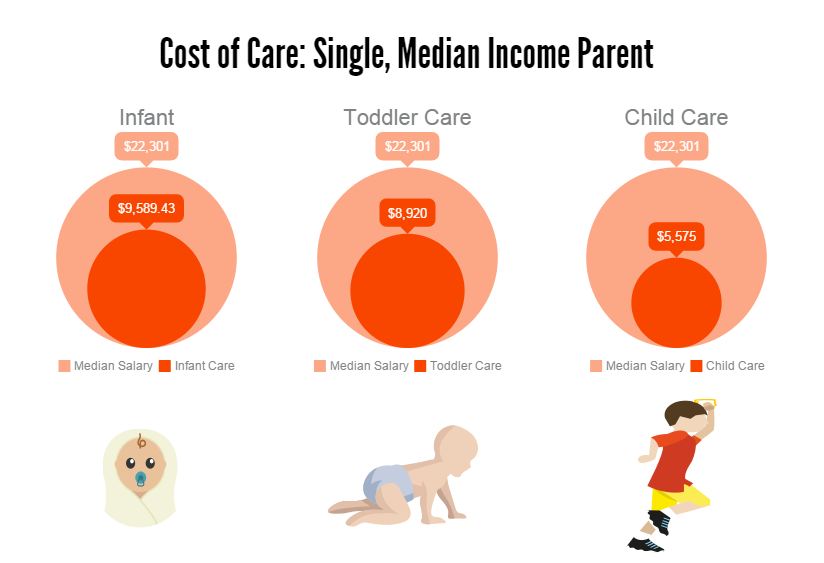Census 2020: Key Takeaways from the Decennial Census Count in Maine
Helen Hemminger, Research and KIDS COUNT Associate
What is the Census and why does it matter?
By law, the Census is used to allocate federal funding, as well as to determine Congressional representation. When kids aren’t counted, communities don’t get their fair share of federal dollars for Head Start, school lunch, public health insurance, housing, child care and various other programs and services that help young children. For this reason, a complete and accurate census is critical. Yet 2020 was an extraordinarily difficult year to conduct the once-every-ten years Census. The pandemic, as well as natural disasters and a political climate that made immigrant populations fearful to complete the federal Census, all contributed.
Challenges for an accurate count in the 2020 Census
While many activities to encourage households to complete the Census were already finished when the pandemic struck one month before the official count day of April 15, 2020, COVID-19 certainly changed how the US Census Department did their work, as well as how organizations like ours promoted the Census. Because of the pandemic, there was a delay in the non-response door-to-door part of the US Census operations, and that was especially important in Maine, since Census forms are not allowed to be mailed to post office boxes. With an older and more rural population, some households in Maine also lacked internet access or the know-how to complete the Census online. The pandemic also affected non-profit outreach strategies to reach typically undercounted populations, including plans to set up mobile hot spots, organizing Census stations at libraries, and sending Census information packets home from school with students. The shift to online created new opportunities , however, including distribution of information through food bank boxes, childcare and other social service organizations, doctors’ offices, and social media.
Maine Children’s Alliance promotion of the 2020 Census
MCA worked for over 18 months to engage and recruit credible messengers to promote the importance of counting all young children in the Census. MCA staff gave presentations to targeted audiences, totaling approximately 2,380 people, who were then able to promote the Census to an additional 70,000 people. Other outreach efforts included opinion pieces in the press and a physical mailing to pediatricians, midwives, and obstetricians. MCA worked with the Maine Association for the Education of Young Children to send monthly emails to child care providers and coordinated additional Census activities with the League of Women Voters.
New boundaries for Maine’s federal house districts
The US Census released apportionment counts in April 2021 based on the population data collected from Census 2020, and as expected Maine did not gain or lose federal representation as a result. In September 2021, the Maine legislature was able to quickly decide new boundaries for House District 1 and House District 2. Notably, Maine was the second state to enact congressional redistricting and did so by a unanimous vote of the Maine House and Senate.
How Maine’s population changed from 2010 to 2020
National and State level population and household counts based on the Census 2020 are available now on the Census data webpage. According to the US Census 2020 Maine profile , Maine’s population grew 2.6 percent from 2010 to 2020. Furthermore, every county in Maine and the state overall grew more diverse.
More than three times as many people in Maine self-identified as two or more races; there were 64,710 people in 2020 categorized as two or more races, compared to 20,941 in 2010. While the population of white alone in Maine declined by 2.2 percent, the number of people identifying as white or white in combination with another race, grew by 1.2 percent. The American Indian population declined in Maine by 8.0 percent, (from 8,568 to 7,885 people) but the American Indian alone or in combination with another race, grew by 81.3 percent, with American Indian/white growing from 8,729 to 23,177 from 2010 to 2020. More comparisons between 2010 and 2020 can be found at the US Census Interactive Comparison Tables.
Concerns about the extent of the undercount in the nation and in Maine
The US Census is still conducting tests to understand the magnitude of the undercount. One concern is that young children are still among the most undercounted populations. Black, Indigenous, Hispanic and other people of color are also disproportionately undercounted. Despite the pandemic, the self-response rate nationally increased slightly from 2010 to 2020 , probably due to adding the option in 2020 of completing the Census online. Maine’s 2020 self-response rate increased as well, at 58.2 percent, up from 57.4 percent in 2010. Those who did not self-respond were counted through non-response follow-up (door-to-door), as well as by matching administrative records, but the most complete and accurate results come when respondents complete the Census themselves.
A Georgetown University researcher predicts that based on self-response rate data for 2020 , the groups that were undercounted in previous Censuses including Black, American Indian, Hispanic, foreign-born, renters, people with low incomes and children under age five, are all likely to have been undercounted in the 2020 Census. According to Urban Institute's Microsimulation of Census 2020, the estimated undercount of the overall population in Maine is 0.29 percent compared to the national average of 0.5 percent. The estimated undercount of young children in Maine is 3.6 percent, compared to the national average of 4.86 percent. There are also concerns from an equity standpoint, since the Urban Institute projected that Maine’s undercount of Black individuals was 5.67 percent, compared to a national average of 2.45 percent.
The Democracy Funders Committee's Maine state level report provides an overview of philanthropic efforts to promote the 2020 Census within and across the 50 states. For Maine, the report found that urban communities along the coast of southern Maine where much of Maine’s population lives, as well as some communities near the Canadian border, had self-response rates higher in 2020 than 2010; meanwhile, in many very rural areas, where households often have post office boxes instead of street addresses, the self-response rates were lower in 2020 than in 2010.
Looking ahead: Lessons learned to apply to Census 2030
The Democracy Funders Committee produced a summary from all the states about the Census promotion including funding, structure, successful strategies, enabling conditions and challenges. This document can guide the promotion of the 2030 Census. Important considerations for an accurate count include financial support for outreach efforts by trusted messengers, utilization of technology and communications like social media, and the inclusion of communities who are historically undercounted in the planning and implementation of Census efforts.







